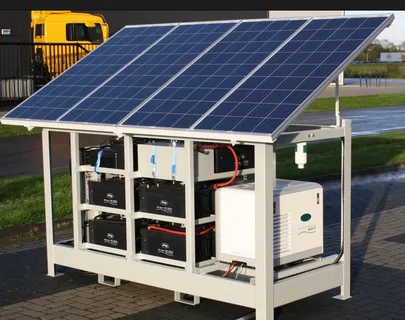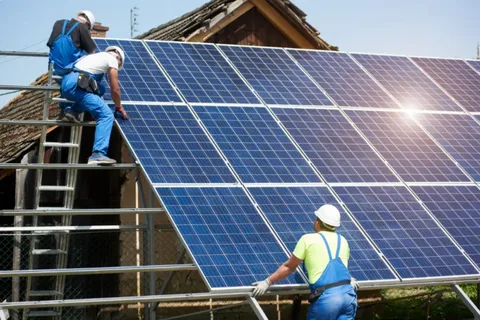In today’s world, the need for renewable energy sources is more critical than ever. With the rise of climate change and the depletion of traditional fossil fuels, the search for alternative energy solutions has become a top priority. Stand Alone Solar Power is one such solution that is gaining traction because of its ability to provide clean, sustainable energy. This blog post will explore why Stand-Alone Solar Power is the key to achieving energy independence.
Understanding Stand-Alone Solar Power Systems
Stand-alone solar Power Systems represent a transformative approach to energy generation, designed for complete autonomy from the traditional power grid. These systems are an amalgamation of solar panels, which harness sunlight, batteries that store this captured energy for later use, and inverters that convert the stored energy into electricity usable in homes and businesses. A distinctive feature of these systems is their ability to operate independently, providing a reliable energy source without connecting to a centralized power source. This independence is particularly beneficial in remote locations where grid access is either unavailable or prohibitively expensive. Additionally, Stand-Alone Solar Power Systems can be customized to meet specific energy requirements, making them a versatile option for a wide range of residential and commercial applications. The integration of these components ensures a consistent and eco-friendly power supply, underlining the system’s importance in moving towards a more sustainable and self-sufficient energy model.
Stand Alone Solar Power System
A Stand Alone Solar Power System, offers a robust solution for those seeking autonomy over their energy resources. This system is uniquely designed to cater to various energy needs without the necessity of connecting to the conventional power grid. Its modular nature allows for scalability, enabling users to expand their system based on evolving energy demands. One of the key advantages of such systems is the flexibility in installation locations, making it an ideal choice for remote or rural areas where grid connectivity is a challenge. Optimal system performance hinges on careful consideration of component selection, including the type of solar panels, battery storage capacity, and the inclusion of an efficient inverter. This ensures that the system meets the immediate energy requirements and is future-proofed against increasing consumption or technological advancements. By harnessing solar energy through a stand-alone solar power system, users can achieve a significant reduction in energy costs over time while contributing to a greener planet. This system embodies the principle of self-sufficiency in energy production, highlighting solar power’s practicality and environmental benefits.
How Stand-Alone Solar Power Promotes Energy Independence
Stand-Alone Solar Power is pivotal in fostering energy independence by liberating households and businesses from the unpredictable dynamics of conventional power sources. This liberation stems from the capacity of Stand-Alone Solar Power systems to generate electricity directly from sunlight, an abundant and perpetually renewable resource. The essence of energy independence lies in the empowerment of individuals and communities to produce their electricity, which in turn minimizes their dependence on the complex infrastructure and fluctuating costs associated with traditional energy sources like coal, oil, and natural gas.
The deployment of Stand-Alone Solar Power systems signifies a shift towards a more decentralized approach to energy generation. By enabling energy production at the point of use, these systems diminish the reliance on extensive transmission networks that are often vulnerable to disruptions and outages. Furthermore, the capability of these systems to store energy in batteries for later use enhances resilience, ensuring a stable and continuous power supply even during periods of low sunlight.
In essence, Stand-Alone Solar Power systems equip users with the tools to control their energy destiny. By adopting these systems, individuals and communities can attain a level of autonomy over their energy production and consumption, paving the way towards a sustainable, self-sufficient, and independent energy future.
Stand Alone Solar Panels
Stand-alone solar Panels are the heart of any Stand-Alone Solar Power system, capturing the sun’s rays and converting them into usable electricity. These panels are photovoltaic cells that absorb sunlight and generate direct current (DC) electricity. The technology behind these panels has advanced significantly, leading to higher efficiency rates and the ability to produce more power even in less-than-ideal lighting conditions. When selecting Stand Alone Solar Panels, it’s essential to consider factors such as efficiency, durability, and the panel’s size relative to your energy needs. The panels are available in various types, including monocrystalline, polycrystalline, and thin-film, each with its advantages and specific applications. The choice of solar panels plays a crucial role in the overall performance and efficiency of a Stand-Alone Solar Power system, making it imperative to opt for high-quality components that can withstand environmental factors and deliver sustainable energy production over the long term.
Stand Alone Solar Panel System
A Stand Alone Solar Panel System is a comprehensive configuration tailored for generating, storing, and converting solar energy for individual use without reliance on the external electrical grid. The architecture of this system is crucial for maximizing energy efficiency and ensuring a constant supply of power. It begins with the strategic placement of Stand solar panels alone to capture optimal sunlight. These panels are then connected to a battery bank, where the energy is stored until needed. The inclusion of a charge controller within the system prevents overcharging of the batteries, extending their lifespan and ensuring safety. An inverter is another essential component, converting stored DC power into AC power and making it compatible with the electrical systems used in homes and businesses. For those looking to augment their system, additional features such as solar trackers can be integrated to enhance solar panel efficiency by following the sun’s trajectory across the sky, thereby increasing energy capture. By meticulously configuring each element, a Stand-Alone Solar Panel System delivers a reliable and self-contained power solution, tailored to meet the unique energy demands of its users. This bespoke approach enables the harnessing of solar energy to its fullest potential, making it a linchpin in the quest for energy independence.
Getting Started with Your Own Stand-Alone Solar Power System
Embarking on the journey to install a Stand-Alone Solar Power system begins with a clear evaluation of your energy necessities and financial plan. Collaborating with a solar energy expert is crucial; they can provide invaluable guidance on the optimal size and layout for your system based on your specific energy consumption patterns. A detailed assessment will help identify the most efficient and cost-effective components, including the choice of solar panels and battery storage capacity, to meet your needs. Additionally, understanding local regulations and available incentives can significantly influence your project’s overall feasibility and cost-effectiveness. It’s also advisable to consider the future expansion of your energy requirements and ensure that the design of your Stand-Alone Solar Power system can accommodate such changes. Preparing for the installation involves selecting a suitable location for the solar panels, where they will receive maximum sunlight, and ensuring that the site is ready for the equipment. Once everything is in place, you can look forward to generating your own electricity, contributing to environmental sustainability, and enjoying the freedom that comes with energy independence. Engaging with a reputable installer will ensure that your system is configured for optimal performance and complies with all relevant standards and regulations.
The Future of Energy: Why Stand-Alone Solar Power Matters
As the global community faces the challenges of climate change and resource depletion, Stand-Alone Solar Power emerges as a crucial solution in the quest for sustainable energy. Its significance extends beyond the immediate benefits of reducing carbon emissions and harnessing a clean, inexhaustible energy source. Stand-alone solar Power systems represent a paradigm shift towards decentralized, local energy production, empowering individuals and communities to take charge of their energy needs. This shift is vital for resilience against the backdrop of increasing energy demands and the vulnerability of centralized power systems to disruption. Furthermore, as technological advancements continue to enhance the efficiency and affordability of solar components, Stand-Alone Solar Power becomes more accessible, encouraging widespread adoption. This democratization of energy production has the potential to drive economic growth, particularly in underdeveloped regions, by providing reliable power for education, healthcare, and commerce. The role of Stand-Alone Solar Power in shaping the future of energy is thus not only about environmental stewardship but also about fostering equity, resilience, and autonomy in energy resources globally.
Small Stand Alone Solar System
A Small Stand Alone Solar System offers a streamlined, efficient solution for those seeking to dip their toes into the realm of solar power without committing to a full-scale installation. Tailored for powering small-scale operations, such as outdoor lighting, garden sheds, or even tiny homes, these systems embody the essence of flexibility and practicality. Comprising a compact set of solar panels, a modest battery storage unit, and a suitable inverter, small stand-alone systems can effortlessly meet the energy requirements of low-demand applications. This scalability not only makes solar power accessible to a broader audience but also demonstrates the adaptability of solar technology to diverse energy needs. By choosing a small stand-alone system, individuals can significantly reduce their environmental footprint, enjoy the benefits of renewable energy, and experience the autonomy of producing their electricity, albeit on a smaller scale. Moreover, these systems serve as an excellent starting point for those new to solar power, providing a foundational understanding of solar energy generation and management, without the overwhelming complexity or investment associated with larger setups.
FAQs
How dependable are Stand-Alone Solar Power systems for daily use?
Stand-Alone Solar Power systems are engineered for resilience and longevity. Equipped with advanced technology and quality components, these systems are capable of providing sustainable energy solutions for an extended period, often several decades, with routine upkeep.
What is the financial outlay for setting up a Stand-Alone Solar Power system?
The investment required for a Stand-Alone Solar Power system varies based on its scale and specifications. Residential setups can range between $10,000 and $20,000 prior to applying any governmental incentives or rebates, which can significantly offset the initial cost
Can Stand-Alone Solar Power systems generate power under overcast conditions?
Yes, Stand-Alone Solar Power systems remain operational during cloudy weather, albeit at reduced efficiency. The systems are designed to collect and store surplus energy in battery banks during sunny periods, ensuring a continuous power supply, even when solar irradiance is temporarily diminished.
Conclusion
In wrapping up our exploration of Stand-Alone Solar Power, it’s clear that this technology stands at the forefront of a revolution in how we approach energy generation and consumption. The transition to solar energy is not just an environmental imperative but also a strategic move towards self-reliance and economic savings. Stand-Alone Solar Power systems offer a tangible solution for individuals and communities to break free from the constraints and volatility of conventional energy sources. By adopting these systems, we embrace a future where energy is not only clean and sustainable but also more equitable and accessible. The journey towards energy independence with Stand-Alone Solar Power is a step towards reshaping our energy landscape, fostering resilience against the challenges of climate change, and ensuring a stable supply of power in an increasingly unpredictable world.
| Other Good Articles to Read |
| Skank Blogs |
| Unreal Blogs |
| Tba Blogs |
| All City Forums |
| Dany Blogs |
| Refuge Blogs |
| The Music Blogs |
| Key Forums |
| The Big Blog Theory |
| Joe Blogs |
| Blogs 4 Me |
| Blogs Emon |
| Related Business Listings |
| Contact Directory |
| Local Business Profiles |



